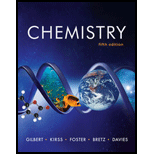
Concept explainers
(a)
Interpretation: The diameter and the length of the nonorod of gold is given. The approximate number of atoms of gold present in each nanorod; the number of unit cells corresponding to each nanorod and the mass of each nanorod is to be calculated.
Concept introduction: The volume of the cylinder is calculated by the formula,
The volume of the sphere is calculated by the formula,
To determine: The approximate number of atoms of gold present in each nanorod.
(a)
Answer to Problem 12.94AP
Solution:
The approximate number of atoms of gold present in each nanorodis
Explanation of Solution
Given
The diameter of the nanorodis
The height of the nanorodis
The volume of the cylinder is calculated by the formula,
Substitute the value of diameter and height in the above equation.
The radius of the gold atom is
The volume of the sphere is calculated by the formula,
Substitute the value of the radius of gold sphere in the above equation.
Therefore, the number of gold atoms present in each nanorod is,
(b)
To determine: The number of unit cell of gold corresponding to each nanorod.
(b)
Answer to Problem 12.94AP
Solution:
The number of unit cell of gold corresponding to each nanorodis
Explanation of Solution
The unit cell of gold is face centered.
Therefore, there are four atoms of gold present in each unit cell.
The number of unit cell of gold corresponding to each nanorodis
Therefore, the number of unit cell corresponding to each unit cell is,
(c)
To determine: The mass of each nanorod.
(c)
Answer to Problem 12.94AP
Solution:
The mass of each nanorodis
Explanation of Solution
The mass of one mole of gold is
The mass of each atom is calculated by the formula,
Substitute the value of mass of one mole of gold and
The number of unit cell of gold corresponding to each nanorodis
Therefore, the mass of each nanorod is,
Conclusion:
The approximate number of atoms of gold present in each nanorodis
The number of unit cell of gold corresponding to each nanorodis
The mass of each nanorodis
Want to see more full solutions like this?
Chapter 12 Solutions
Smartwork5 Printed Access Card for Use with Chemistry: The Science in Context 5th Edition (SmartWork Access Printed Access Card)
 ChemistryChemistryISBN:9781305957404Author:Steven S. Zumdahl, Susan A. Zumdahl, Donald J. DeCostePublisher:Cengage Learning
ChemistryChemistryISBN:9781305957404Author:Steven S. Zumdahl, Susan A. Zumdahl, Donald J. DeCostePublisher:Cengage Learning ChemistryChemistryISBN:9781259911156Author:Raymond Chang Dr., Jason Overby ProfessorPublisher:McGraw-Hill Education
ChemistryChemistryISBN:9781259911156Author:Raymond Chang Dr., Jason Overby ProfessorPublisher:McGraw-Hill Education Principles of Instrumental AnalysisChemistryISBN:9781305577213Author:Douglas A. Skoog, F. James Holler, Stanley R. CrouchPublisher:Cengage Learning
Principles of Instrumental AnalysisChemistryISBN:9781305577213Author:Douglas A. Skoog, F. James Holler, Stanley R. CrouchPublisher:Cengage Learning Organic ChemistryChemistryISBN:9780078021558Author:Janice Gorzynski Smith Dr.Publisher:McGraw-Hill Education
Organic ChemistryChemistryISBN:9780078021558Author:Janice Gorzynski Smith Dr.Publisher:McGraw-Hill Education Chemistry: Principles and ReactionsChemistryISBN:9781305079373Author:William L. Masterton, Cecile N. HurleyPublisher:Cengage Learning
Chemistry: Principles and ReactionsChemistryISBN:9781305079373Author:William L. Masterton, Cecile N. HurleyPublisher:Cengage Learning Elementary Principles of Chemical Processes, Bind...ChemistryISBN:9781118431221Author:Richard M. Felder, Ronald W. Rousseau, Lisa G. BullardPublisher:WILEY
Elementary Principles of Chemical Processes, Bind...ChemistryISBN:9781118431221Author:Richard M. Felder, Ronald W. Rousseau, Lisa G. BullardPublisher:WILEY





